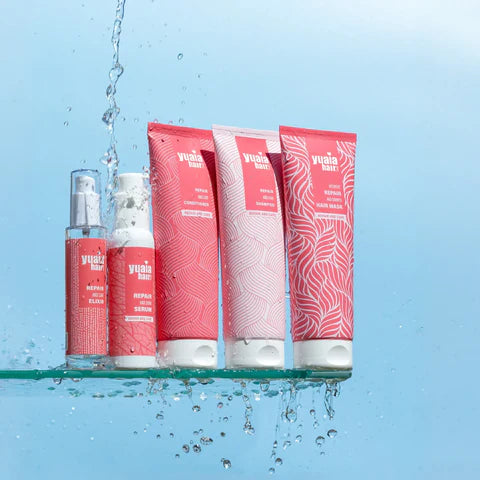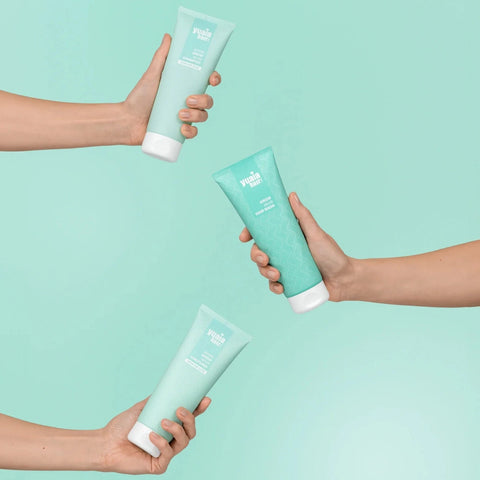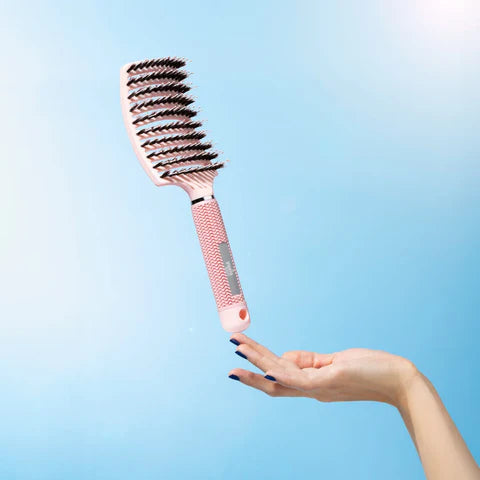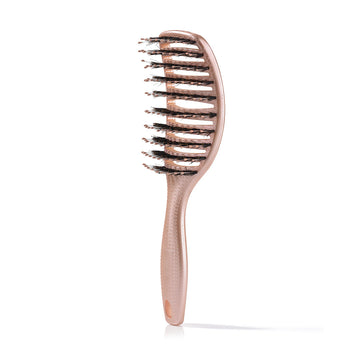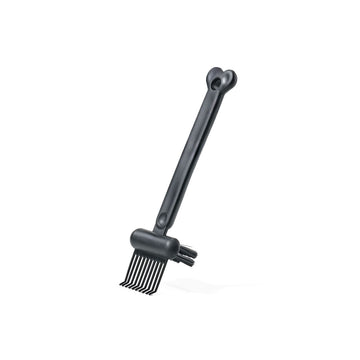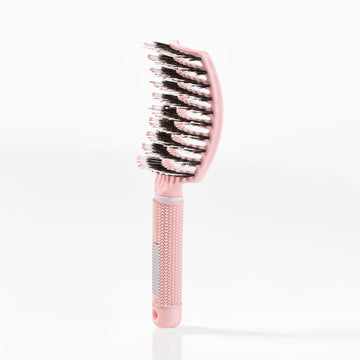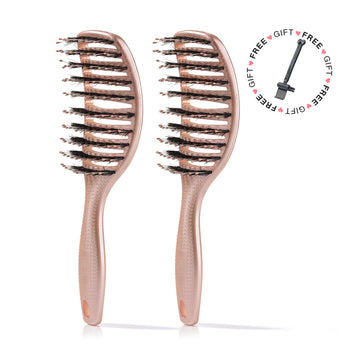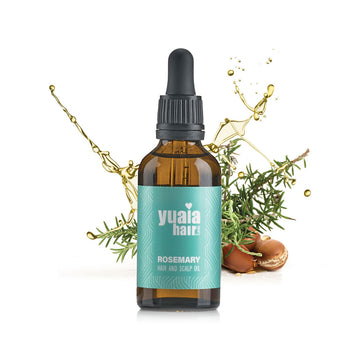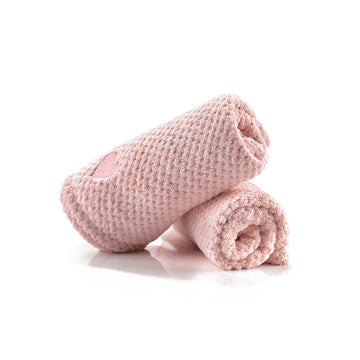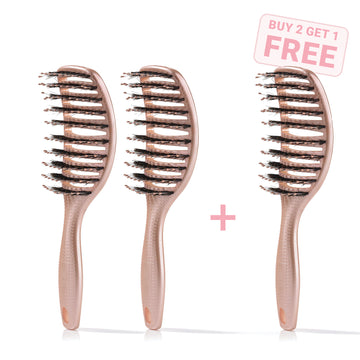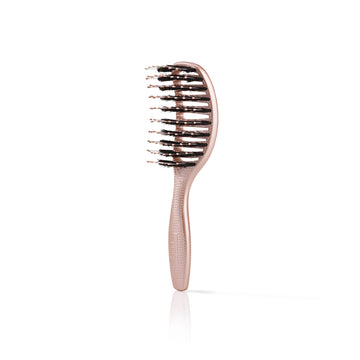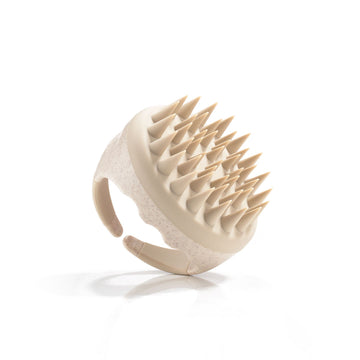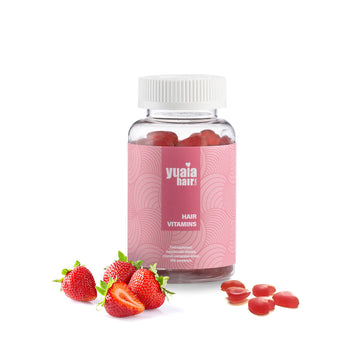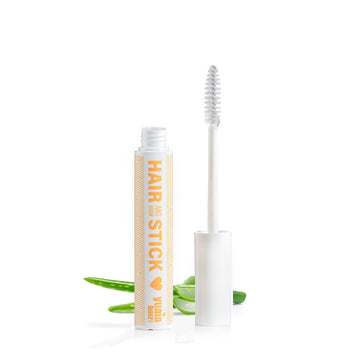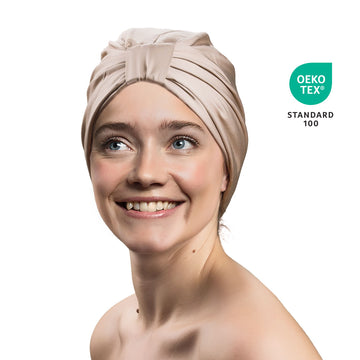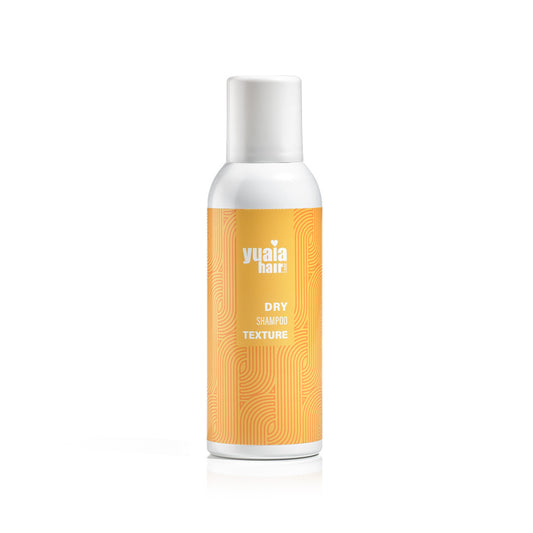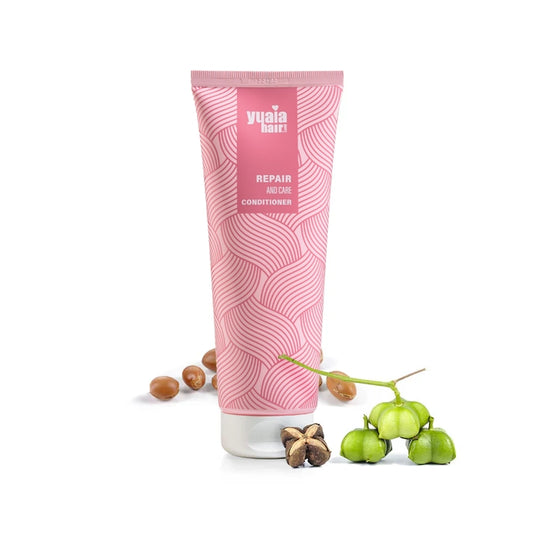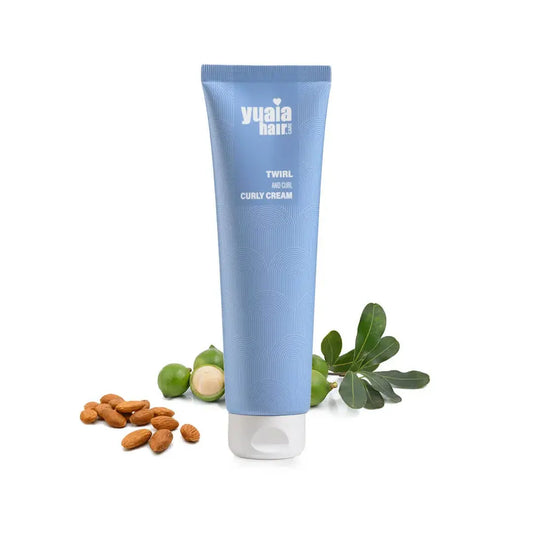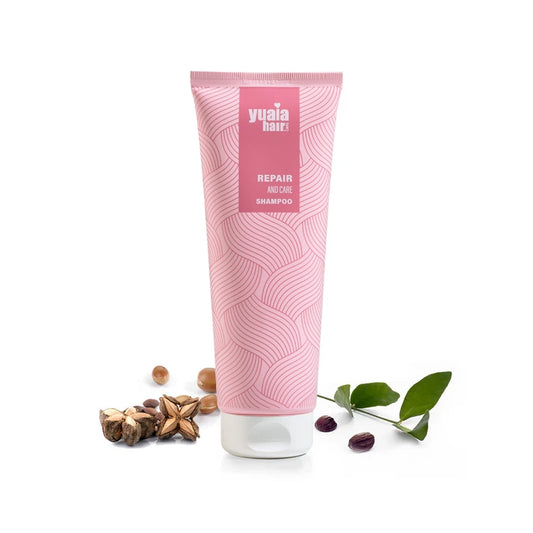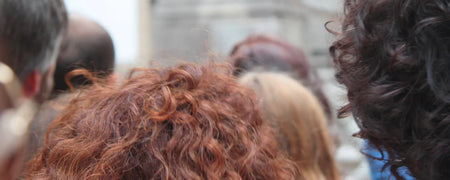
Understanding the different hair textures
Hair texture plays a central role in how your hair behaves and responds to care. While often confused with hair type, texture specifically refers to the thickness of each individual strand and is typically categorized as fine, medium or coarse. Recognizing your hair texture helps you tailor your routine more precisely, particularly when choosing between lightweight versus richer products.
Fine hair consists of very small-diameter strands that may feel silky but are more prone to oiliness and limpness. It tends to be delicate and can easily become weighed down by heavy products or over-conditioning. Volumizing shampoos, dry shampoos and lightweight styling foams are especially beneficial for adding body without buildup.
Medium hair has a strand diameter that falls between fine and coarse. It generally holds styles well and strikes a balance between strength and flexibility. Most hair products are formulated with medium texture in mind, so this group has the broadest range of care options.
Coarse hair features thick strands that may feel rougher to the touch and are more resilient. It often requires more moisture to remain soft and manageable. Rich conditioners, oil-based treatments and heat protection products are important for keeping coarse strands nourished and protected.
Because texture can vary across your head, many people find they have a mix, such as finer strands at the crown and coarser strands at the nape. This variation calls for targeted care across different sections of the hair, rather than a one-size-fits-all routine.
Overview of the overall 4 hair types and 12 subtypes
The Andre Walker system categorises hair into four main types, each with three subtypes that reflect variations in curl pattern, texture and volume. This widely used framework helps you better understand their hair’s natural structure, from straight to tightly coiled. Knowing your type can guide product choices and styling techniques.
Type 1 (Straight)
Type 1 hair is naturally straight and does not form curls or waves. It lies flat from root to tip and reflects light well, often appearing shiny. While it may look sleek, it can also be prone to oil buildup or lack of volume. Each subtype varies in texture and thickness, which influences how the hair behaves and what care it responds best to.
1A: Very fine and flat with no natural wave or curl. This hair type tends to lie close to the scalp and can appear thin or limp. It is typically prone to oil buildup due to the straight path of the hair shaft, which allows sebum to travel easily. Lightweight, volumizing shampoos and dry shampoos can help add body without weighing the hair down.
1B: Straight but with some natural body. This subtype has a bit more texture than 1A and can hold volume slightly better, though it still lacks defined wave or curl. It may be prone to frizz in humid conditions and benefits from light smoothing serums and hydrating conditioners to manage flyaways without reducing fullness.
1C: Straight with a coarse feel and more volume. This hair type appears fuller and may have a slight bend or very subtle wave. It is more resistant to styling and can be frizz-prone, especially in damp weather. Nourishing treatments and anti-frizz products help maintain smoothness while preserving the hair’s natural thickness.
Type 2 (Wavy)
Type 2 hair features a natural wave pattern, ranging from loose S-shaped bends to more defined structures with a tendency to frizz. It sits between straight and curly hair and therefore requires balanced care that adds moisture while enhancing the wave definition without weighing the hair down. Wavy hair often has a smoother surface than curly hair but can still struggle with volume and frizz, especially in humid conditions.
2A: Loose, stretched S-waves with a fine and smooth texture. The hair lies flat against the scalp and often lacks root volume. It rarely frizzes but can easily become weighed down by heavy products. Lightweight options such as mousses or sea salt sprays work well to provide lift and hold without disrupting the wave pattern.
2B: More defined S-waves with medium density and some frizz. This subtype has a clearer shape and responds well to light styling products that enhance structure and control frizz. Moisturising formulations without silicones or heavy oils are ideal to maintain a natural look.
2C: Thick, pronounced waves with occasional spirals and noticeable frizz. This subtype tends to have more volume and a coarser texture, requiring both moisture and definition. Leave-in conditioners, creams and gels are helpful for enhancing wave shape while maintaining elasticity and controlling frizz.
Type 3 (Curly)
Type 3 hair is naturally curly and forms clear S-shaped waves or spirals. This hair type tends to be drier than straight hair, as the curls make it harder for the scalp’s natural oils to travel down the hair shaft. The curls vary in tightness and diameter and often require moisturizing products to maintain definition and minimize frizz.
3A: Large, loose curls with a soft texture. These curls often have a natural shine and can be prone to frizz in humid conditions. People with 3A hair typically find their curls are well-defined when air-dried and benefit from curl-enhancing gels and lightweight leave-in products to maintain bounce and prevent flattening.
3B: Springy ringlets with more volume. This subtype features curls that are tighter than 3A and often vary in diameter. 3B hair can have a mix of textures throughout the head, requiring extra moisture and frizz control. Styling creams and defining products can help maintain curl shape and structure.
3C: Tight corkscrew curls with a coarse texture. These curls are densely packed, creating a lot of volume but also more susceptibility to dryness and shrinkage. Deep conditioning, oil-based moisturizers and protective styling techniques are especially helpful for this type to maintain elasticity and reduce breakage.
Type 4 (Coily/Kinky)
Type 4 hair is defined by very tight, compact coily curls that range from clearly defined spirals to almost invisible patterns. This hair type often has a coarse texture and is highly prone to dryness, as the scalp’s natural oils have difficulty traveling down the hair shaft. Shrinkage is common, and the hair can contract significantly when it dries. To maintain elasticity, moisture, and structure, this hair type requires a targeted care routine with hydrating products and protective styling techniques.
4A: Soft, springy coils with a well-defined S-shaped pattern. The hair typically has a fine to medium texture and a natural sheen, though this can fade with dryness. This subtype tends to shrink moderately when air-dried and benefits from creamy leave-in products, light oils, and moisturizing styling creams that support bounce and shape without weighing the hair down.
4B: Tighter curls with a Z-shaped structure and less visible definition. The hair often feels coarser and has a drier surface. Rather than forming smooth spirals, these curls bend at sharp angles, making the hair more susceptible to shrinkage and breakage. A routine based on the LOC or LCO method, along with oil-based moisturizers and protective hairstyles, helps maintain hair health and structure.
4C: Extremely tight, densely packed coils with minimal visible curl definition. This subtype often has a coarse texture and is the most fragile of all hair types, meaning it dries out and breaks easily. 4C hair can shrink up to 75 percent of its actual length and needs intense moisture care. Frequent deep conditioning treatments, generous use of leave-in conditioners, and protective styles like braids and twists are especially effective for preserving strength, moisture, and flexibility.
How to find out your hair type and texture at home
To accurately assess your hair type and texture, begin by washing your hair with a gentle, sulfate-free shampoo.
Allow it to air-dry naturally without the use of heat tools or styling products. This reveals your hair’s natural curl pattern and helps distinguish its unique characteristics.
For texture, take a single dry strand and roll it between your fingers. If it’s hard to feel, the strand is fine. If it feels strong or thick, it is likely coarse.
To test porosity, place a clean strand in a glass of water. High porosity hair sinks quickly, while low porosity hair floats longer due to its resistance to absorbing moisture.
Check density by tying your hair into a ponytail. A thinner circumference indicates low density, whereas a fuller ponytail suggests high density.
Lastly, assess elasticity by stretching a wet strand. Healthy hair will stretch and return. If it breaks easily, it lacks elasticity.
Real-life routine examples
Understanding your hair type and texture allows for more effective product choices and care routines. For example:
A person with fine, straight (1A) hair may benefit from volumizing shampoos and lightweight conditioners to add lift without causing buildup or heaviness.
Someone with thick, curly (3C) hair often requires richer products such as heavy creams, leave-in conditioners and regular deep conditioning treatments to maintain moisture, reduce frizz and define curl shape.
Those with coily (4B or 4C) hair typically benefit from the LOC or LCO method (liquid, oil, cream) and protective styles, both of which help retain moisture and reduce breakage.
Variability and evolution of hair
Hair can change over time due to age, hormonal shifts, medication, and environmental factors. It’s not unusual to notice more waves or curls appearing later in life, or for hair to become finer or coarser with time. You might also have multiple types or textures on different parts of your head, especially if you've chemically treated or heat-styled parts of your hair.
Building a routine that fits your hair's unique needs
Once you’ve identified your hair type, texture, porosity and density, you can tailor your hair care more effectively.
Low porosity
Hair with low porosity tends to resist moisture absorption. Using heat when applying hydrating products can help the moisture penetrate more deeply. Avoid heavy formulas that tend to sit on the surface rather than being absorbed.
High porosity
Hair with high porosity absorbs moisture easily but loses it just as quickly. A good approach is to layer your products: start with hydrating formulas and then seal in moisture with an oil.
Match products to your hair texture
Fine hair needs lightweight products that won't weigh it down, helping maintain volume and shape. In contrast, coarse hair benefits from rich creams and oils that add moisture, soften the strands and make daily styling and care more manageable.
General care advice
Regardless of hair type, include a deep conditioning treatment weekly or biweekly, clarify product buildup about once a month and protect your hair at night with silk or satin to preserve moisture and reduce friction.
Understanding your hair type and texture
Knowing your hair’s type and texture makes it easier to choose the right products and routines. It removes unnecessary trial and error and helps you develop a care routine that suits your specific needs. Whether your hair is straight or tightly coiled, the right approach starts with this insight.
Frequently Asked Questions
How do I determine if my hair is fine, medium, or coarse?
To determine your hair texture, take a single dry strand and roll it between your fingers. If it’s hard to feel, your hair is fine. If it feels strong or thick, it is likely coarse. Medium hair falls in between, feeling neither too thin nor too thick.
Can my hair type or texture change over time?
Yes, hair type and texture can change due to factors like age, hormonal changes, medication, and environmental influences. It’s common to notice more waves or curls as you age, or for your hair to become finer or coarser over time.
What is the difference between hair porosity and hair texture?
Hair texture refers to the thickness or diameter of each strand, while porosity describes how well your hair absorbs and retains moisture. Porosity is tested by placing a clean strand in water—high porosity sinks quickly, low porosity floats longer.
How often should I wash my hair based on its type and texture?
Fine or straight hair may need washing more frequently due to oil buildup, while coarse, curly, or coily hair can often go longer between washes to preserve natural moisture. Adjust your routine based on how your scalp and hair feel.
What products are best for high porosity hair?
High porosity hair benefits from hydrating products layered with oils or creams to seal in moisture. Look for leave-in conditioners, deep treatments, and oils that help retain hydration and reduce frizz.
 2-4 day UK delivery
2-4 day UK delivery
 25.000+ satisfied customers
25.000+ satisfied customers
 Satisfaction Guarantee
Satisfaction Guarantee



